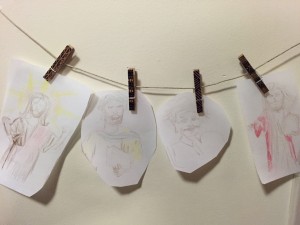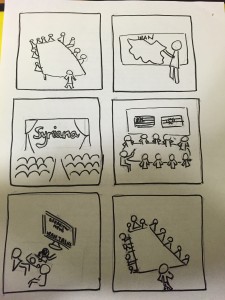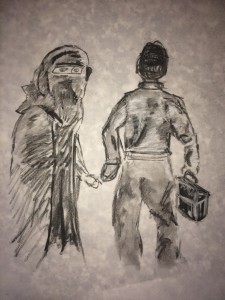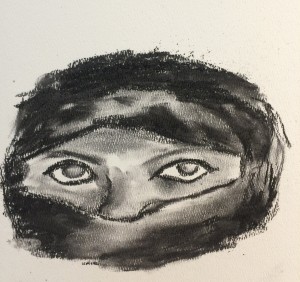An Introduction to my Blog
ø
Looking back at the semester in this seminar, and at all of the stories, poems, novels, and other works of literature that I have read shows me how much I have learned in a relatively short period of time about life, human interactions, cultures and religions as a whole. Throughout the course we travelled the world, reading about Islam in the context of the Middle East, Central and South Asia, as well as sub-Saharan Africa. When I reflect on the creative responses I made in reflection of the literature we read, I see both the wide scope of the setting and also the universality of certain themes.
Most apparent to me is the variety of women’s roles portrayed in this literature. Women’s roles are not standardized across cultures, even cultures who practice the same religions. I was somewhat surprised by this upon entering the course because I had the false impression the women’s roles in Islam were largely the same, and that they were very restricted. This was no doubt because of the portrayal of Muslim women in American media. Powerful Muslim women are always shown as unusual, and something to be celebrated. While this important, it nevertheless undermines the potential for all Muslim women to be empowered. For this reason, I was excited to read The Swallows of Kabul and Sultana’s Dream. Sultana’s Dream showed the passionate command displayed when women used their intelligence to win a war. After reading this novel I felt empowered to do the same, to fight using my brain rather than brute strength or weapons. But, in the end, as I reflected in my poem, it was still a dream. The theme of female empowerment reappeared in The Swallows of Kabul when Zunaira refused to wear the attire demanded by the extremists. This was an inspiring display of self-determination and even though eventually she did wear the burka, her outright refusal and confidence in standing up to her husband showed that she had power in their relationship. This was an exciting evolution from Sultana’s Dream, because I felt it showed the transition from the early 20th century to the 21st century in terms of women’s roles suggested by Islam.
While I realize that I have just mentioned perception of women’s roles suggested by Islam, I wish to comment on another concept that I learned and have developed a more complete understanding of throughout the course of the semester. The concept of Islam, and religion in general as a construction is one that is hugely important to remember when considering contemporary international conflicts regarding religion. In reading these piece of Muslim literature, I have realized the wide variety of practices, characters, settings, and outcomes that all fall under the umbrella of one great religion. So often people unfamiliar with the religion view Muslims as “terrorists” and the religion as “violent”. The very first reading of the year described this phenomenon, saying that Islam and other religions as well as America and other nationalities too often become personified and connected to various singular ideas. It is of the utmost importance that one separates the followers of the religion from the religion itself, and the people living in the country from “the country’s” ideas.
In addition to the idea of women’s roles in society, the search for an ideal religion as well as an ideal society in general was prevalent across the readings. I thoroughly enjoyed readings such as Children of the Alley and The Journey of Ibn Fatouma that focused on such debates. I found the way in which these novels were structured to show and evaluate the options available to mankind to be extremely thought-provoking. By putting the various religions and societal structures in an indirect competition, Mahfouz allowed the reader to consider the ideal society. Interestingly, the resolutions of these stories were never final. I enjoyed Mahfouz’s style because it allowed for the reflection while reading. In some ways, however, the reflection was somewhat pessimistic, for example, Mahfouz suggested in Children of the Alley that religion and science are both ultimately successful in ruling the alley. The Journey of Ibn Fatouma was slightly less pessimistic in that it showed the possibility of reaching heaven, or an ideal society, but it showed faults of every other real-life society. Because of this it both allowed the reader to ponder the ideal society, and also implied that such society is not actually attainable on Earth. In my opinion, this showed the importance of religion, to fill in the gaps that the real world cannot attain. It also shows the importance of an after life as a crucial aspect of these religions. By leaving the “right answer” ambiguous, I believe that Mahfouz really etched a role for religion into a society that promotes secularization.
The theme of secularism was also prevalent throughout the stories we read this semester. From The Saint’s Lamp to The Wedding of Zein, these stories demonstrated pros and cons of religion. In The Wedding of Zein, the contrast between Seif and Zein served to underscore the importance of religion as a pathway to good character. It also showed that there is a path to redemption even if one gets off track at times. My sketch of the auspicious dates falling off of the tree represents the symbol that initiated redemption in the case of Seif ad-Dein, as well as the period of prosperity that followed. In The Wedding of Zein, secularism lost the battle. In The Saint’s Lamp, instead of misbehavior of all sorts, the secularism was represented by science. By pouring the oil from the lamp into Fatima’s eyes, Ismail’s mother acts against science, in a way that suggests traditional religion does not understand the concepts important to one’s wellbeing. Interestingly however, Ismail was not able to use his scientific insight when this unfortunate event occurred, making it harder for him to find success with science or the secular practice. Religion was unsuccessful as well, but it is frustrating for Ismail that he is unable to prevent Fatima from being permanently blinded.
While many stories discussed the ideal role of religion, also interesting were the stories that discussed the ideal practice of religion. In both The Complaint and The Answer as well as The Beggar’s Strike, the practice of religion is an important factor in understanding the culture and literature as a whole. I felt these two stories in particular aligned with one another because they brought questions of class into the discussion of the best practice of Islam. This was of particular interest to me because it connects the culture and the caste system to the traditions of Islam. In The Answer, God implied that the lower castes and poorer people were the more devout Muslims, and that the wealthier people should look up to them and worship God as they do. I found this interesting, because it showed the ways religion and religious literature is influenced by socio-economic status. Literature is a powerful tool to display this connection because it can create a voice for God based on current events, something that is not possible by reading the bible. In this way it is a dynamic representation of God’s leadership role with his followers.
The concept of dynamically representing God’s relationship with and leadership of his followers was seen no better than in The Beggar’s Strike, when the wealthy townspeople could no longer give offerings to the poor after they had removed them from the city. This was God’s way of saying that the higher castes need to respect and treat the lower castes well. I appreciated this sentiment and the concept of both groups relying on one another tremendously, which is why I created a charcoal drawing of the hands. These hands are the perfect symbol of the complex power dynamic between the rich and the poor. In writing The Beggar’s Strike, Aminata Sow Fall gives God power and a voice that he wouldn’t otherwise have in this context. He shows that God is watching and maintaining the multifaceted relationship between the rich and the poor. It is important to maintain this dynamic relationship, because without it the poor suffocate at the hands of the rich, and the rich do not get into heaven, having created an enemy of those to whom they need to give alms. Like in The Complaint and The Answer, The Beggar’s Strike facilitates a vehicle with which to perpetuate the correct practice of religion and the important opinion of God.
Overall, throughout the course of the semester, I have been made aware of themes not only in Islam, but in religion in general. Studying religion through literature has given me the opportunity to study the transformation of religion throughout time. After all, being a construct, religion is dynamic; this quality is vital to its longevity. One of the most notable aspects of this course has been its ability to guide me to a more powerful understanding of the importance of religion. Previously I had not been a serious Christian, but this course has truly fostered my interest in the study of religion in general. I am thankful to have taken this course this semester, as it has prepared me to be a knowledgeable consumer of political events and contemporary opinion of Islam, as well as an educated consumer of religion.






